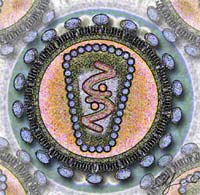
![]() Immunity to viral infections sounds like a good thing, but it can come at a price. Millions of years ago, we evolved resistance to a virus that plagued other primates. Today, that virus is extinct, but our resistance to it may be making us more vulnerable to the present threat of HIV.
Immunity to viral infections sounds like a good thing, but it can come at a price. Millions of years ago, we evolved resistance to a virus that plagued other primates. Today, that virus is extinct, but our resistance to it may be making us more vulnerable to the present threat of HIV.
 Many extinct viruses are not completely gone. Some members of a group called retroviruses insinuated themselves into our DNA and became a part of our genetic code. Indeed, a large proportion of the genomes of all primates consists of the embedded remnants of ancient viruses. Looking at these remnants is like genetic archaeology, and it can tell us about infections both past and present.
Many extinct viruses are not completely gone. Some members of a group called retroviruses insinuated themselves into our DNA and became a part of our genetic code. Indeed, a large proportion of the genomes of all primates consists of the embedded remnants of ancient viruses. Looking at these remnants is like genetic archaeology, and it can tell us about infections both past and present.
When retroviruses (such as HIV, right) infect a cell, they insert their own DNA into their host's genome, using it as a base of operations. From there, the virus can pop out again and make new copies of itself, re-infect its host or move on to new cells.
If it manages to infect an egg or sperm cell, the virus could pass onto the next generation. Hidden inside the embryo's DNA, it becomes replicated trillions of times over and ends up in every single one of the new individual's cells.
These hitchhikers are called 'endogenous retroviruses'. While they could pop out at any time, they quickly gain mutations in their DNA that knocks out their ability to infect. Unable to move on, they become as much a part of the host's DNA as its own genes.
In 2005, a group of scientists led by Evan Eichler compared endogenous retroviruses in different primates and found startling differences. In particular, chimps and gorillas have over a hundred copies of the virus PtERV1 (or Pan troglodytes endogenous retrovirus in full). Our DNA has none at all, and this is one of the largest differences between our genome and that of chimps.
Our ancestors shared a similar geographical range to the ancestors of these apes, and would have encountered the same viruses, including PtERV1. And yet, we were spared from infection, while the apes were not. Why?
 Shari Kaiser and colleagues from the University of Washington and the Fred Hutchinson Cancer Research Center believed that the answer lies in a protein called TRIM5α that defends us from retroviruses. It latches onto the outer coat of incoming viruses, and tells other proteins to dismantle or destroy them.
Shari Kaiser and colleagues from the University of Washington and the Fred Hutchinson Cancer Research Center believed that the answer lies in a protein called TRIM5α that defends us from retroviruses. It latches onto the outer coat of incoming viruses, and tells other proteins to dismantle or destroy them.
Other primates have their own versions of TRIM5α that protect against a different range of viruses, and the protein has evolved dramatically in different primate lineages. Kaiser believed that our version of TRIM5α protected us from PtERV1, while that of other apes did not. To test her idea, all she had to do was to resurrect a dead virus.
Obviously, PtERV1 is long extinct, but its remnants exist inside the genomes of chimps. Kaiser compared dozens of these remnants and by identifying common elements, she worked out the ancestral sequence of the virus.
She created a small part of PtERV1 and fused it with bits of a modern virus, MLV, to create a fully-functioning hybrid. To nullify any potential for spread beyond the lab, she crippled the virus so that it could infect once and only once.
The reconstructed virus successfully infected mammal cells in a lab, but not when human TRIM5α was around. The guardian protein demolished the virus's infectivity, reducing it by more than 100 times. As Kaiser predicted, our genomes are free of PtERV1 because TRIM5α killed it before it could reach our DNA.
But this protection carries a price - it makes us vulnerable to HIV. Over the course of primate evolution, humans made an important change in the amino acid sequence of TRIM5α that allowed the protein to fight off PtERV1. When Kaiser changed the protein back to its original form, she found that it gained the ability to fight off HIV, but lost its resistance to PtERV1.
In fact, Kaiser found that no primate species has a version of TRIM5α capable of fighting off both viruses at the same time. We are resistant to ptERV1 and vulnerable to HIV, but chimps, gorillas, baboons and rhesus macaques show the reverse strengths and weaknesses.
When it comes to retrovirus immunity, there is no win-win situation. Having defeated one enemy, we have unwittingly made ourselves more vulnerable to another.
Reference: Kaiser, Malik & Emerman. 2007. Restriction of an extinct retrovirus by the human TRIM5a antiviral protein. Science 316:1756 - 1758.
More on HIV and retroviruses:




It's obvious what should be done: genetically engineer humans (in the germline, for win) to express the other TRIM5a Allele/Paralog and Retrocylins.
Excellent post! I had always wondered how ERV's become, well, retro and endo.
oversimplified? Human Trim5a restricts murine retroviruses that are not related to Pt ERV1 or other remnant human and primate viruses.